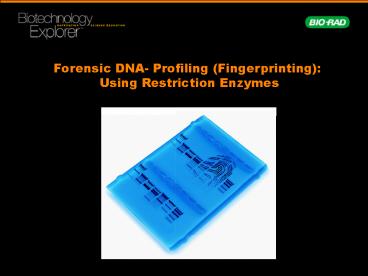Forensic DNA- Profiling (Fingerprinting): - PowerPoint PPT Presentation
1 / 19
Title:
Forensic DNA- Profiling (Fingerprinting):
Description:
Forensic DNA- Profiling (Fingerprinting): Using Restriction Enzymes DNA Profiling Fingerprinting Real World Applications Crime scene Human relatedness ... – PowerPoint PPT presentation
Number of Views:693
Avg rating:3.0/5.0
Title: Forensic DNA- Profiling (Fingerprinting):
1
Forensic DNA- Profiling (Fingerprinting) Using
Restriction Enzymes
2
DNA ProfilingFingerprinting Real
WorldApplications
- Crime scene
- Human relatedness
- Paternity
- Animal relatedness
- Anthropology studies
- Disease-causing organisms
- Food identification
- Human remains
- Monitoring transplants
3
DNA is Tightly Packaged into Chromosomes Which
Reside in the Nucleus
4
Model of DNADNA is Comprised of Four Base
Pairs
5
Deoxyribonucleic Acid (DNA)
6
DNA Schematic
O
Phosphate
P
O
O
Base
O
O
CH2
Sugar
O
P
O
O
Phosphate
Base
O
O
CH2
Sugar
OH
7
DNA Restriction Enzymes
Evolved by bacteria to protect against viral
DNA infection Endonucleases cleave within
DNA strands Over 3,000 known enzymes
8
5 vs 3 Prime Overhang
Enzyme cuts
Generates 5 prime overhang
9
Enzyme Site Recognition
Restriction site
Palindrome
Each enzyme digests (cuts) DNA at a specific
sequence restriction site Enzymes recognize
4- or 6- base pair, palindromic sequences (eg
GAATTC)
Fragment 2
Fragment 1
10
Common Restriction Enzymes
EcoRI Eschericha coli 5 prime overhang
Pstl Providencia stuartii 3 prime overhang
11
DNA FingerprintingProcedureOverview
12
Animations Videos
- Videos
- How restriction enzymes work to create DNA
profiles - http//highered.mcgraw-hill.com/sites/0072437316/s
tudent_view0/chapter16/animations.html - How micropipets work
- http//www.youtube.com/watch?vkCm2t1SO2IU
- How electrophoresis works
- http//learn.genetics.utah.edu/content/labs/gel/
- PCR modern method of DNA profiling
http//highered.mcgraw-hill.com/sites/0072437316/s
tudent_view0/chapter16/animations.html
13
LaboratoryQuick Guide
14
AgaroseElectrophoresisLoading
- Electrical current carries negatively-charged
DNA through gel towards positive (red) electrode
Buffer
Dyes
Agarose gel
Power Supply
15
AgaroseElectrophoresisRunning
- Agarose gel sieves DNA fragments according to
size - Small fragments move farther than large
fragments
Gel running
Power Supply
16
Analysis of Stained Gel
- Determine
- restriction fragment
- sizes
- Create standard curve using DNA marker
- Measure distance traveled by restriction
fragments - Determine size of DNA fragments
- Identify the related
- samples
17
DNA DigestionTemperature
- Why incubate at 37C?
- Body temperature is optimal for these and most
other enzymes - What happens if the temperature is too hot or
cool? - Too hot enzyme may be denatured (killed)
- Too cool enzyme activity lowered, requiring
- longer digestion time
18
Restriction Fragment Length PolymorphismRFLP
PstI
EcoRI
GAATTC GTTAAC
CTGCAG GAGCTC
Allele 1
1
2
3
GAATTC GTTAAC
CGGCAG GCGCTC
Allele 2
3
Fragment 12
Different Base Pairs No restriction site
M
A-1
A-2
Electrophoresis of restriction fragments M
Marker A-1 Allele 1 Fragments A-2 Allele 2
Fragments
19
Molecular Weight Determination
Fingerprinting Standard Curve Semi-log
- Size (bp) Distance (mm)
- 23,000 11.0
- 9,400 13.0
- 6,500 15.0
- 4,400 18.0
- 2,300 23.0
- 2,000 24.0































